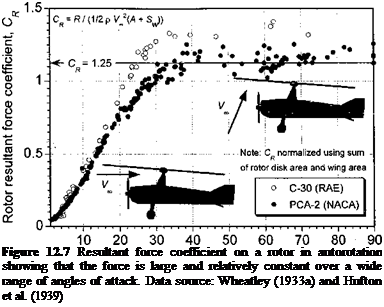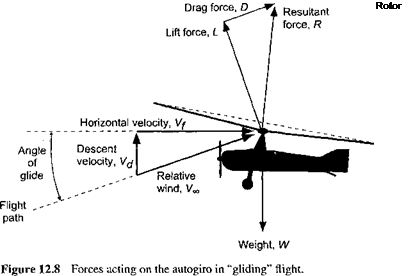Autogiro Theory Meets Practice
In 1925, Juan de la Cierva was invited to Britain by H. E. Wimperis [see also Wimperis (1926)] of the British Air Ministry and was provided with financial backing by the industrialist James G. Weir of the Weir Company. Cierva was shortly thereafter to found the Cierva Autogiro Company, Ltd. and Britain was then to become the home for Cierva’s work. His company was not set up for manufacturing, however, but for technical studies, management of patents and awarding of licenses to build his Autogiros. His Autogiros instead were built by established aircraft manufacturers, including the Avro (A. V. Roe) Company. Pitcairn and Kellett in the United States were later to become major licensees and were to produce various derivatives of the Cierva machines. This saw the beginning of the Pitcaim-Cierva Autogiro Company of America. In 1933, this enterprise was to become simply the Autogiro Company of America. See Harris (1992) for a history.
Cierva’s C-6 Autogiro was demonstrated at the RAE in 1925 and in the same year Cierva gave the first of three historical technical lectures to the membership of the RAeS [Cierva (1926)]. At the end of this (and all of the other lectures) there was considerable debate on the merits of his Autogiro. Cierva gave another lecture in 1930 [Cierva (1930a)] at a time when more than 100 autogiros were flying in Britain and the United States and he was to document the rapid technical developments of the autogiro that had taken place during the preceding five years. His final lecture and paper [Cierva (1935)] was to the RAeS in 1934 and he then described in detail the “jump” takeoff technique and the direct rotor control device (see Section 12.14).
Cierva’s first demonstration flights and lectures in Britain stimulated early experimental and theoretical work on rotating-wing aerodynamics by H. Glauert and C. Lock. Their theoretical work was pioneering and was supported by relatively advanced wind tunnel measurements on model rotors [see Lock & Townend (1928)]. In 1926, Glauert (1926) published a classic paper that was to be the first theoretical treatise on induced inflow and rotor performance – see also Glauert (1927). Glauert’s analysis quantified rotor performance in horizontal, climbing, and descending flight and set down the basic equations that could be used to relate rotor performance to certain design parameters. However, in descent or in autorotation (in particular) the theory was not exact, and even since then, there has been no exact theory derived from first principles to fully describe the aerodynamics of a rotor
Hub plane angle of attack – deg.
 |
in the autorotative state. However, Cierva vehemently disagreed with Glauert’s analysis, based on his own theories and also his practical flight testing experience with the C-6. In a formal letter lodged with the RAeS, Cierva (1927) disagreed with Glauert’s estimation of the vertical autorotative rate of descent, claiming values for “practically vertical descents” that were half of Glauert’s estimate. He goes on further to draw concerns “with almost every point contained in Mr. Glauert’s developments.” Glauert seems to have been unruffled by such harsh criticism, standing confidently behind his theoretical studies – see Glauert (1927).
With hindsight, Glauert was probably closer to the truth of the matter than Cierva might have given him credit for. The analysis conducted previously has shown that the vertical rate of descent can be related to the rotor disk loading. The same result can be approached using measurements of the resultant force acting on the autorotating rotor, which are shown in Fig. 12.7. Cr is the resultant force coefficient, where R is the resultant force on the rotor as given by R = VL2 + D2, with L as the rotor lift force and D as the rotor drag force – see Fig. 12.8. It is significant that the resultant Cr on the rotor at large angles of attack (greater than 30°) is about 1.25 and nearly equivalent to the drag coefficient, Co, of a circular disk with a flow normal to its surface (i. e., at high angles of attack the rotor acts like a bluff body with its attendant turbulent downstream wake). Recall from page 92 that Co = 1-33 for an open hemisphere, which means that aerodynamically the rotor produces a resultant force equivalent to a parachute when in the vertical autorotative state. Yet, this was a-point vigorously disputed by Cierva (1930b). Herein lies the difficulty in analyzing the aerodynamics of the rotor, because the rotor in its autorotative flow state at low airspeeds creates a complex turbulent wake and, in fact, is often said to operate in the “turbulent wake” state – see Fig. 2.20. With forward speed, however, the flow state in autorotation is much smoother.
Later, Harold Pitcairn urged Cierva to consolidate his vast engineering knowledge of the autogiro and in 1929 commissioned him to write a reference book for American engineers. The first Cierva book was titled Engineering Theory of the Autogiro – see Cierva
 |
(1930c). Sufficient data had been measured and analysis conducted that “a theory could be developed covering many probabilities of performance and possibilities of design beyond the actual achievement in construction to that time.,r [Cierva & Rose (1931)]. Later, Cierva wrote a comprehensive design manual titled Theory of Stresses in Autogiro Rotor Blades. Neither document was formally published, but they were copyrighted and made available to engineers at Pitcairn, the Kellett Autogiro Company, the NACA, the US Air Force, and the Bureau of Aeronautics. These engineering documents helped greatly in the certification of autogiros manufactured (and later designed) in the United States. Today, few original copies of these books exist, but they are a valuable chronicle in the technical development of rotating wing aircraft.











